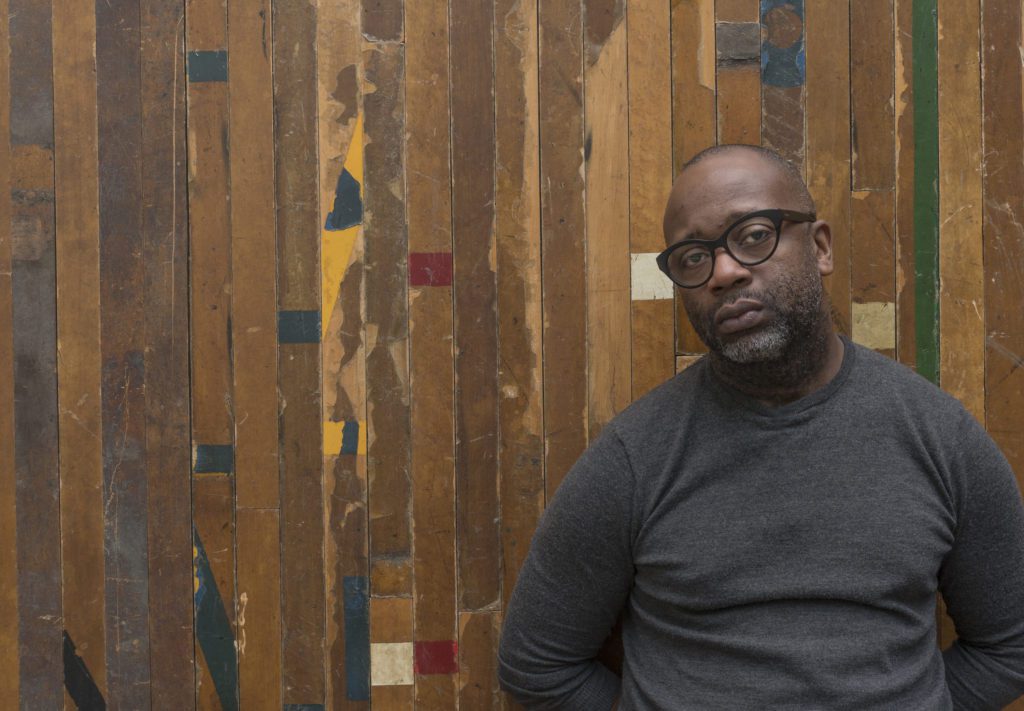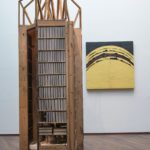In the Tower at the National Gallery: Theaster Gates
By • March 22, 2017 0 1000

Walking into the Tower of the National Gallery of Art’s East Building, you are greeted by monuments. Towering planes and structures of stone and wood reach toward the skylights of the austere gallery space, evincing a near Romanesque grandiosity of sheer scale — political or cultural landmarks removed from their context and floating in space.
Yet these monuments are alien, nothing like any structure you have seen before. They could easily be construction refuse, delicately conserved artifacts of urban building projects, worn shingles and scuffed wood floors repurposed and recontextualized for a contemporary aestheticism. The installation asks that you consider sacred what you would ordinarily ignore and find beauty in the abandoned artifacts of midcentury development.
This is the work of cross-disciplinary American artist Theaster Gates, who weaves together personal and cultural narratives, creating objects that speak both to a particular time and place and to the arc of American history. Popularly known for large-scale projects that transform vacant buildings into works of art, Gates has said that he is motivated by a desire to “reenvision place … not just as an art project, but as a way of living.”
Presenting a new body of work, “Theaster Gates: The Minor Arts” examines how discarded and ordinary objects acquire value through the stories we tell. On view through Sept. 4, it is the artist’s first solo exhibition on the East Coast.
Born in 1973, Gates makes work focused on racism and poverty in America, seeking to make change in downtrodden communities. His practice is grounded in African American history and culture and in his own experience growing up on the South Side of Chicago. Slavery, industrial exploitation and the civil rights movement feature prominently in his sculptures, installations and performances, into which he incorporates such materials as shoeshine stations and fire hoses.
During the 2008 financial crisis, Gates decided to focus on fostering improvement through art. Starting in his own neighborhood and expanding to other communities, he has effectively rejuvenated numerous abandoned buildings, transforming them into vibrant social hubs and cultural spaces.
“The Minor Arts” imagines a world in which up is down, the past is present and the marginalized becomes central. Salvaging discarded materials found in and around Chicago, Gates responds to the decline of urban institutions and traditions and resurrects them as art. At the same time, he draws from African sculpture and unheralded forms of craft and labor, including the homegrown traditions of roofing and ceramics.
In one work, Gates brings the slate roof of a decommissioned church down to eye level, making it into a wall, part fortress and part mosaic. In another, he scrambles the wood from the gym floors of shuttered high schools, giving it the staccato rhythm of geometric abstraction and transporting it from the arena of sport to art.
Repurposing old copies of Ebony magazine, a seminal publication of African American life and culture, the artist constructs a towering inverted library. And he creates a landscape painting out of roofer’s tar, mopping the viscous black material onto yellow Naugahyde to form a vibrant sunset.
As with his larger projects, Gates created this exhibition out of his collections of “modern castoffs,” a term he uses for materials that technology, the market and American history have left behind. The objects refer to the decline of urban institutions and traditions through their use of elements like the high school gym floors and the demolished slate roof.
The environment he creates in the National Gallery is also rich with art-historical allusion. A small funerary sculpture on a slab of columnar tiled marble is at once reminiscent of African tribal carvings and of Cycladic marble idols that decorated tombs in 2000 B.C. It looks not unlike their female figures, thought to represent the mother and fertility goddess.
- Installation view of “New Egypt Sanctuary of the Holy Word and Image” and “12 Suns with Sunset,” 2017. Theaster Gates. Courtesy National Gallery of Art.
- Installation view of “New Egypt Sanctuary of the Holy Word and Image” and “Elegua in Winter,” 2017. Theaster Gates. Courtesy National Gallery of Art.
- Installation view of “A Game of My Own,” 2017. Theaster Gates. Courtesy National Gallery of Art.
Meanwhile, there is something distinctly reminiscent of Duchamp in the found and fetishized objectry of the roof tiles. The gym-floor piece could easily be exhibited alongside work by Washington Color School artists like Gene Davis or Sam Gilliam, whose giant planes of stripes and flat color suggest the world’s infinite planes of geometric dimension. Its grated textural surface is further reminiscent of Abstract Expressionists like Clyfford Still.
“The Minor Arts” reorients the world around us, placing invisible labor, forgotten stories and overlooked craft at its center. Shuffling existing hierarchies, Gates gives new form to the outdated and the left-behind, and stakes a claim for the artfulness of the ever




